
U.S. President Donald Trump’s dream of a supersized manufacturing base could turn nightmarish for companies across the country, according to a report from Scotiabank. Already faced with a shortage of workers, negative demographic trends and hawkish immigration policy, the rebuild could take years, perhaps even decades to execute. It might not even work.
“One in five U.S. manufacturers is already struggling with labour shortages in their production facilities,” said John McNally, senior advisor, climate and socio-economic policy research at Scotiabank Economics. He wrote the report with research help from Neha Sarraf, a climate and socio-economic research analyst. “The demographic trends aren’t super-favourable for the sector right now.”
The desire to expand its manufacturing base makes sense, McNally said. But Trump’s vision is expensive at best, unfeasible at worst.
According to the report, fully substituting imports with U.S.-produced goods would require about a 36% increase in output — that figure would vary, industry by industry. Getting there would mean onboarding roughly 7.7 million workers, in addition to the 12.8 million currently employed by U.S. manufacturing companies.
That total would constitute about 15% of the private labour force. The country has not had that much of its population employed in the sector since 2001, before China joined the World Trade Organization.
Those numbers can come down with big technology spends, but companies are still going to need a lot more people if you’re going to reverse the country’s trade imbalances.
“You could see a lot of automation,” McNally said. “We modelled one version in which productivity effectively doubled … and that would still require some fairly aggressive labour force growth. There’s just a lot of additional workers that would be required to help grow production to the levels needed to fully substitute for final goods.”
Something close to 4 million workers would have to be added in this more optimistic model, according to the report. “In real terms, that’s about 3% of the U.S. private labour force,” he said.
The national unemployment rate was 4.1% in February, according to the U.S. Bureau of Labor Statistics. That rate is well within the range experts use to describe full employment.
Meanwhile, population growth rates in the U.S. continue to head in the wrong direction. The U.S. Bureau of Labor Statistics forecasts that the civilian noninstitutional population — Americans 16 or older, who are not in the military or an institution such as a prison or health facility — will grow by just 0.6% each year between 2023 and 2033. That’s down 20 basis points relative to the previous 10-year period.
Unless Washington is prepared to set aggressive immigration targets, labour shortages are likely to persist.
American manufacturers are already struggling to find people. The report notes that in the third quarter of last year, 21% said that not having enough workers kept them from operating at full capacity. If employers are in a position to offer better pay, that could be inflationary.
“It is likely that you see those cost flow-throughs contribute to rising inflation, and that rising inflation could subsequently dent consumption,” McNally said. If wages rise high enough, workers from other sectors will be drawn in, driving costs up across the broad economy.
In that scenario, Americans could see higher interest rates and ironically, a tougher environment for U.S. exporters.